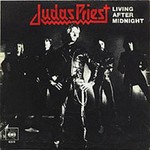This article needs additional citations for
verification. (December 2009) |
| "Living After Midnight" | ||||
|---|---|---|---|---|
 | ||||
| Single by Judas Priest | ||||
| from the album British Steel | ||||
| Released | 21 March 1980 | |||
| Recorded |
| |||
| Genre | ||||
| Length | 3:31 | |||
| Label | Columbia | |||
| Songwriter(s) | ||||
| Producer(s) | Tom Allom | |||
| Judas Priest singles chronology | ||||
| ||||
| Music video | ||||
| "Living After Midnight" on YouTube | ||||
"Living After Midnight" is a song by English heavy metal band Judas Priest. [3] It was originally featured on their 1980 album British Steel, [4] which was their first gold album in the United States selling more than 500,000 copies (and eventually went platinum for selling at least one million). [5] The song speaks to the hedonistic, rebellious spirit of the late 1970s and early 1980s, and is among the band's most popular songs.
Background
The song title came about when Glenn Tipton awakened Rob Halford with his loud guitar playing at 4 AM, during the band's stay at Tittenhurst Park to record British Steel. Halford commented to Tipton that he was "really living after midnight", and Tipton replied that Halford's comment was a great title for the song he was working on. [6]
Video
The music video, directed by Julien Temple and shot live at the Sheffield City Hall, begins with drummer Dave Holland playing an invisible drum kit. During the guitar solo, fans on the front row play along with their cardboard guitars (which were the prominent fan symbols of the new wave of British heavy metal movement).
Reception
PopMatters said, "'Living After Midnight' still sticks in the craws of some fuddy-duddy metal old-timers, but as trite as this little party anthem is, its hook is irresistible and glorious, the sound of a band learning that it never hurts to have a little fun once in a while. The song is oddly clean-cut, hedonism rendered a little innocent, and kind of sweet." [7] BBC agreed it, "epitomised the new breed of radio friendly metal". [8]
In 2012, Loudwire ranked the song number five on its list of the 10 greatest Judas Priest songs, calling it, "Perhaps the greatest Judas Priest song to sing along with," [9] and in 2019, Louder Sound ranked the song number three on its list of the 50 greatest Judas Priest songs. [10]
Cover versions
This song has been covered by The Donnas on their album The Donnas Turn 21 (2001), by Saul Blanch on the tribute album Acero Argentino: Tributo a Judas Priest (2006), by L.A. Guns on Hell Bent Forever: A Tribute to Judas Priest (2008) and by Iron Savior as a bonus track on the Japanese release of their Condition Red (2002) album.
It was covered by Disturbed on the Tribute to British Steel (2010) CD by Metal Hammer UK music magazine, incorporating the opening drum salvo from " Painkiller". It also appears as one of the bonus songs available with some distributions of Asylum (2010), and also features on their B-sides compilation album The Lost Children (2011).
Charts
| Chart (1980) | Peak position |
|---|---|
| Australian Singles ( Kent Music Report) [11] | 91 |
| UK Singles ( OCC) [12] | 12 |
Personnel
- Rob Halford – vocals
- Glenn Tipton – lead guitar
- K. K. Downing – rhythm guitar
- Ian Hill – bass
- Dave Holland – drums
References
- ^ Grow, Kory (25 September 2018). "Ex–Judas Priest Guitarist K.K. Downing on Helping to Define Heavy Metal". Rolling Stone. Retrieved 8 August 2019.
- ^ Popoff, Martin (2003). The Top 500 Heavy Metal Songs of All Time. ECW Press. p. 95. ISBN 978-1-55022-530-3.
- ^ Bayer, Gerd, ed. (2009). Heavy metal music in Britain. Farnham, England: Ashgate. pp. 23. ISBN 9780754664239.
- ^ Vladimir Bogdanov, ed. (2002). All music guide to rock : the definitive guide to rock, pop, and soul (3. ed.). San Francisco, CA: Backbeat Books. p. 605. ISBN 978-0879306533.
- ^ Bowe, Brian J. (2009). Judas Priest: metal gods. Berkeley Heights, NJ: Enslow. ISBN 978-0766036215.
- ^ Prato, Greg (12 June 2012). "Living After Midnight". Rolling Stone. Retrieved 30 May 2018.
- ^ Adrien Begrand. "THE 15 BEST JUDAS PRIEST SONGS". PopMatters.
- ^ Sid Smith. "Judas Priest British Steel Review". BBC.
- ^ Hartmann, Graham (24 August 2012). "10 Best Judas Priest Songs". Loudwire. Retrieved 27 February 2022.
- ^ Chantler, Christ; Lawson, Dom (8 October 2019). "The 50 Greatest Judas Priest songs EVER". Louder Sound. Retrieved 27 February 2022.
- ^ Kent, David (1993). Australian Chart Book 1970–1992 (illustrated ed.). St Ives, N.S.W.: Australian Chart Book. ISBN 0-646-11917-6.
- ^ "Official Singles Chart Top 100". Official Charts Company. Retrieved 20 September 2022.